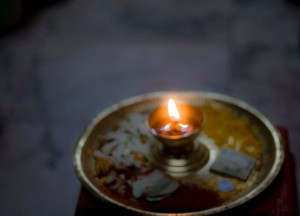In any form of spiritual practice, there is a right relationship that must be maintained. The discipline of searching for a state of inner quiet, of silence, is not to be approached with the goal of becoming a better artist, or even, for that matter, a “better” person. Although greater confidence and greater effectiveness in life may also result in the course of inner development, these are beside the point. The real aim, and the only worthwhile goal of this practice, is true growth of being. Perhaps the greatest danger found in the proliferation of contemporary writings on self-improvement and new age wisdom is the potential for losing sight of this lawful and proper hierarchy. Evidence abounds today of spiritual teachers and students having partial awakenings to a deeper level of consciousness and misappropriating its use for selfish and highly personal ends. Growth of being is organic and must be predicated on a fundamental integration of the whole of ourselves and accompanied by a healthy psychological, sexual, and emotional development.
We use the process of living and of creating art to move toward greater understanding, toward greater consciousness, toward becoming willing servants of that which needs to pass through us from a deeper source. It is a path, a way toward inner development. In Zen it is said that the finger pointing toward the moon should never be confused with the moon itself. Our aim is not to focus on or serve the finger, the path; it is to serve the luminance that creates the moon. In other words, we engage these practices in order to serve life, to serve the higher manifestations both within and without, to serve our real Selves, and to serve others. Life does not exist to serve our egos, our social personalities, our residual childhood complexes, or our material aspirations. Nor do conscious forces exist to support our petty desires and earth-bound selves. The higher should never be used to serve lower ends. The lower should always stand in service of the higher. This is a subtle, but important distinction if we are to use art-making in a respectful manner.
Tools and techniques derived from legitimate spiritual teachings should not be confused with self-help techniques. I know that this sounds like a contradiction in terms, but there is a very deep principle involved here — one that is frequently violated within contemporary culture and even from within contemporary spiritual traditions. This principle is best stated in invoking Dooling’s question: what serves what?
The purpose of a spiritual teaching is to bring us in touch with the higher energies available to us, and for these energies to inform us, teach us, and magnetize our being towards growth of being and consciousness. They are not to be confused with techniques to assist our ego in making a better life or in becoming spiritually superior. They are not designed to serve the ego; rather genuine teachings stand in service of our search for consciousness.
How do we guard against this mixing of levels? People have the right to their own decisions. We do live in a stubbornly democratic society. Yet spiritual work is not necessarily democratic — nor is it for everyone. Knowledge must be earned. And it must be used wisely. Otherwise, it can be dangerous to ourselves and others. In most traditions, a clear distinction is made between the seekers, those who wish to know; the initiates, those who have earned entrance to the more esoteric aspects of a teaching through years of patient work and unfailing efforts; the guides, those who have mastered the initial aspects of a teaching, manifested verifiable results, and are capable of helping others along the way; the teachers, who embody in their very being the core of a teaching; and finally the masters, those who have achieved some measure of awakening and enlightenment. In other words, there is a hierarchy based on one’s level of being and one’s level of preparation. Knowledge is given sparingly, one step at a time, as one gives evidence of being able to use it and benefit from it. The recipients and caretakers of esoteric teachings have no intent of remaining hidden or keeping their knowledge secret — but they understand the power of a real teaching and the need to preserve and protect it from distortion — along with the very real need to gradually prepare an initiate.
Yet we see in contemporary times all manner of individuals writing books and teaching workshops on all manner of things: activating the chakras, opening to energies of the great beyond using a wide variety of techniques — a smorgasbord of methods derived from the world’s traditions, such as tantric practice, yoga, meditation and mindfulness. Some of these are perfectly harmless and even useful. Some are merely watered-down versions — and inevitable distortions — of real teachings. Others can be downright dangerous unless a rigorous screening process is given.
Teachers, writers, publishers, and workshop organizers today hold a position of great trust. What kind of information, and from whom, are we putting forth and placing in front of the public? One fundamental law must be followed: never attempt to teach anything that you do not understand through your own direct experience. A deep sense of responsibility must be adhered to.
“Without an intuition of … different levels, ‘self-knowledge’ and ‘work on oneself’ are reduced to the plane of ‘self-improvement’—‘more’ and ‘better’ of the same thing. Transformation, actual change of being, which is the goal of all true teachings, is forgotten.”
—Dorothea Dooling, The Ladder of Evolution, from Gurdjieff: Essays and Reflections on the Man and His Teaching
Adapted from The Widening Stream: the Seven Stages of Creativity by David Ulrich

